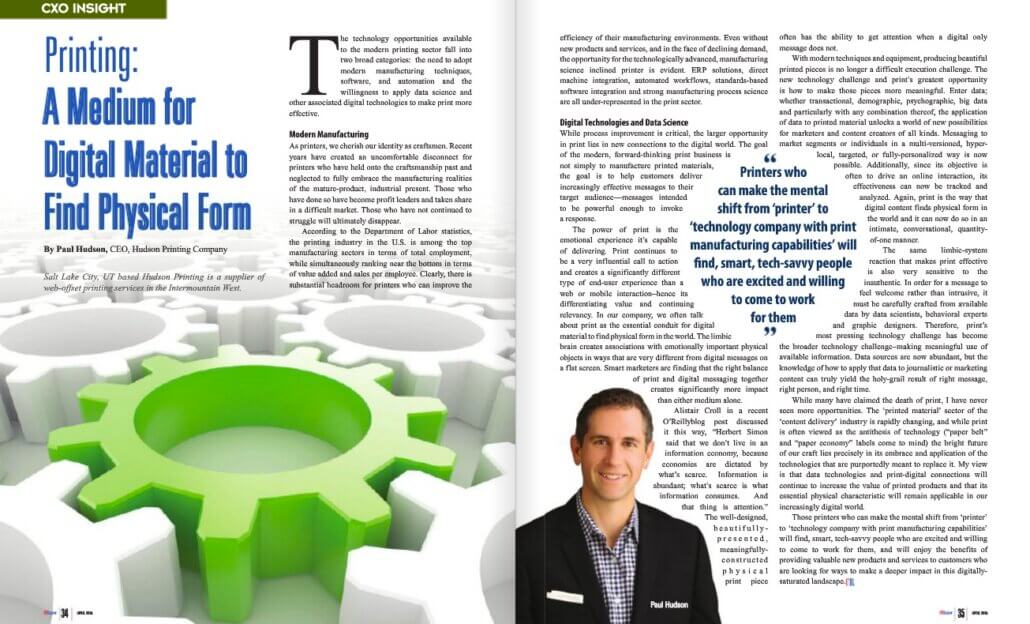[av_textblock size=” font_color=” color=” av-medium-font-size=” av-small-font-size=” av-mini-font-size=” admin_preview_bg=”]
Paul Hudson’s story on disruptive change at Hudson Printing was recently featured in CIO Review magazine. Paul’s focus here is on the importance of technology as Hudson Printing works to Reinvent Print !
Printing: A Medium for Digital Material to Find Physical Form
By Paul Hudson, CEO, Hudson Printing Company
The technology opportunities available to the modern printing sector fall into two broad categories: the need to adopt modern techniques, software, and automation and the willingness to apply data science and other associated digital technologies to make print more effective.
Modern Manufacturing
As printers, we cherish our identity as craftsmen. Recent years have created an uncomfortable disconnect for printers who have craftsmanship past and neglected to fully embrace the manufacturing realities of the mature-product, industrial present. Those who have done so have become profit leaders and taken share in a difficult market. Those who have not continued to struggle will ultimately disappear
According to the Department of Labor statistics, the printing industry in the U.S. is among the top manufacturing sectors in terms of total employment, while simultaneously ranking near the bottom in terms of value added and sales per employee. Clearly, there is substantial headroom for printers who can improve the efficiency of their manufacturing environments. Even without new products and services, and in the face of demand, the opportunity for the technologically advanced, manufacturing science inclined printer is evident. ERP solutions, direct machine integration, automated workflows, standards- integration and strong manufacturing process science are all under-represented in the print sector.
“Printers who can make the mental shift from ‘printer’ to ‘technology company with print manufacturing capabilities’ will find, smart, tech-savvy people who are excited and willing to come to work for them”
Digital Technologies and Data Science
While process improvement is critical, the larger opportunity in print lies in new connections to the digital world. The goal of the modern, forward-thinking print business is manufacture printed materials, the goal is to help customers deliver increasingly effective messages to their target audience—messages intended to be powerful enough to invoke a response.
The power of print is the emotional experience it’s capable of delivering. Print continues to be a very influential call to action and creates a significantly different type of end-u web or mobile interaction–hence its differentiating value and continuing relevancy. In our company, we often talk about print as the essential conduit for digital material to find physical form in the world. The limbic brain creates associations with emotionally important physical objects in ways that are very different from digital messages on a flat screen. Smart marketer right balance of print and digital messaging together creates significantly more impact than either medium alone.
Alistair Croll in a recent O’Reilly blog post discussed it this way, “Herbert Simon said that we don’t live in an information economy, because economies are dictated by what’s scarce. Information is abundant; what’s scarce is what information consumes. And that thing is attention.” The well-designed, beautifully-presented, meaningfully constructed physical print piece often has the ability to get attention when a digital only message does not.
With modern techniques and equipment, producing beautiful printed pieces is no longer a difficult execution challenge. The new technology challenge and print’s greatest opportunity is how to make those pieces more meaningful. Enter data; whether transactional, demographic, psychographic, big data and particularly with any combination thereof, the application of data to printed materials unlocks a world of new possibilities for marketers and content creators of all kinds. Messaging to market segments or individuals in a multi-versioned, hyperlocal, targeted, or fully-personalized way is now possible. Additionally, since its objective is often to drive an online interaction, its effectiveness can now be tracked and analyzed. Again, print is the way that digital content finds physical form in the world and it can now do so in an intimate, conversational, quantity-of-one manner.
The same limbic-system reaction that makes print effective is also very sensitive to the inauthentic. In order for a message to feel welcome rather than intrusive, it must be carefully crafted from available data by data scientists, behavioral experts and graphic designers. Therefore, print’s most pressing technology challenge has become the broader technology challenge – making meaningful use of available information. Data sources are now abundant, but the knowledge of how to apply that data to journalistic or marketing content can truly yield the holy-grail result of right message, right person, and right time.
While many have claimed the death of print, I have never seen more opportunities. The ‘printed material’ sector of the ‘content delivery’ industry is rapidly changing, and while print is often viewed as the antithesis of technology (“paper belt” and “paper economy” labels come to mind) the bright future of our craft lies precisely in its embrace and application of the technologies that are purportedly meant to replace it. My view is that data technologies and print-digital connections will continue to increase the value of printed products and that its essential physical characteristic will remain applicable in our increasingly digital world.
Those printers who can make the mental shift from ‘printer’ to ‘technology company with print manufacturing capabilities’ will find, smart, tech-savvy people who are excited work for them, and will enjoy the benefits of providing valuable new products and services to customers who are looking for ways to make a deeper impact in this digitally-saturated landscape.
printing.cioreview.com
[/av_textblock]


